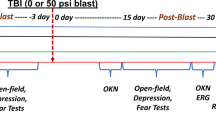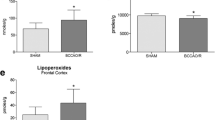Abstract
The endocannabinoid (eCB) system helps recovery following traumatic brain injury (TBI). Treatment with 2-arachidonoylglycerol (2-AG), a cerebral eCB ligand, was found to ameliorate the secondary damage. Interestingly, the fatty acid amino acid amide (FAAA) N-arachidonoyl-L-serine (AraS) exerts similar eCB dependent neuroprotective. The present study aimed to investigate the effects of the FAAA palmitoyl-serine (PalmS) following TBI. We utilized the TBI model in mice to examine the therapeutic potential of PalmS, injected 1 h following closed head injury (CHI). We followed the functional recovery of the injured mice for 28 days post-CHI, and evaluated cognitive and motor function, lesion volume, cytokines levels, molecular signaling, and infarct volume at different time points after CHI. PalmS treatment led to a significant improvement of the neurobehavioral outcome of the treated mice, compared with vehicle. This effect was attenuated in the presence of eCBR antagonists and in CB2−/− mice, compared to controls. Unexpectedly, treatment with PalmS did not affect edema and lesion volume, TNFα and IL1β levels, anti-apoptotic mechanisms, nor did it exert improvement in cognitive and motor function. Finally, co-administration of PalmS, AraS and 2-AG, did not enhance the effect of the individual drugs. We suggest that the neuroprotective action of PalmS is mediated by indirect activation of the eCB receptors following TBI. One such mechanism may involve receptor palmitoylation which has been reported to result in structural stabilization of the receptors and to an increase in their activity. Further research is required in order to establish this assumption.



Similar content being viewed by others
Abbreviations
- 2-AG:
-
2-arachidonoyl glycerol
- AraS:
-
N-arachidonoyl serine
- CHI:
-
Closed head injury
- eCB:
-
Endocannabinoid
- FAAA:
-
Fatty acid amino acid amides
- NF-kappaB:
-
Nuclear factor kappaB
- PalmS:
-
Palmitoyl serine
- TBI:
-
Traumatic brain injury
References
Aguado T, Monory K, Palazuelos J, Stella N, Cravatt B, Lutz B et al (2005) The endocannabinoid system drives neural progenitor proliferation. FASEB J 19(12):1704–1706
Beauchamp K, Mutlak H, Smith WR, Shohami E, Stahel PF (2008) Pharmacology of traumatic brain injury: where is the “golden bullet”? Mol Med 14:731–740
Beni-Adani L, Gozes I, Cohen Y, Assaf Y, Steingart RA, Brenneman DE et al (2001) A peptide derived from activity-dependent neuroprotective protein (ADNP) ameliorates injury response in closed head injury in mice. J Pharmacol Exp Ther 296(1):57–63
Ben-Shabat S, Fride E, Sheskin T, Tamiri T, Rhee MH, Vogel Z et al (1998) An entourage effect: inactive endogenous fatty acid glycerol esters enhance 2-arachidonoyl-glycerol cannabinoid activity. Eur J Pharmacol 353(1):23–31
Bradford MM (1976) A rapid and sensitive method for the quantitation of microgram quantities of protein utilizing the principle of protein-dye binding. Anal Biochem 72:248–254
Chen Y, Constantini S, Trembovler V, Weinstock M, Shohami E (1996) An experimental model of closed head injury in mice: pathophysiology, histopathology, and cognitive deficits. J Neurotrauma 13(10):557–568
Clark RS, Kochanek PM, Schwarz MA, Schiding JK, Turner DS, Chen M et al (1996) Inducible nitric oxide synthase expression in cerebrovascular smooth muscle and neutrophils after traumatic brain injury in immature rats. Pediatr Res 39(5):784–790
Cohen-Yeshurun A, Trembovler V, Alexandrovich A, Ryberg E, Greasley PJ, Mechoulam R et al (2011) N-arachidonoyl-L-serine is neuroprotective after traumatic brain injury by reducing apoptosis. J Cereb Blood Flow Metab 31:1768–1777
Dellu F, Mayo W, Cherkaoui J, Le Moal M, Simon H (1992) A two-trial memory task with automated recording: study in young and aged rats. Brain Res 588(1):132–139
el-Husseini A-D, Bredt DS (2002) Protein palmitoylation: a regulator of neuronal development and function. Nat Rev Neurosci 3(10):791–802
Flierl MA, Stahel PF, Beauchamp KM, Morgan SJ, Smith WR, Shohami E (2009) Mouse closed head injury model induced by a weight-drop device. Nat Protoc 4(9):1328–1337
Gallily R, Breuer A, Mechoulam R (2000) 2-Arachidonylglycerol, an endogenous cannabinoid, inhibits tumor necrosis factor-alpha production in murine macrophages, and in mice. Eur J Pharmacol 406(1):R5–R7
García MC, Adler-Graschinsky E, Celuch SM (2009) Enhancement of the hypotensive effects of intrathecally injected endocannabinoids by the entourage compound palmitoylethanolamide. Eur J Pharmacol 610(1–3):75–80
Hansen HS, Moesgaard B, Petersen G, Hansen HH (2002) Putative neuroprotective actions of N-acyl-ethanolamines. Pharmacol Ther 95:119–126
Hanus L, Shohami E, Bab I, Mechoulam R (2014) N-Acyl amino acids and their impact on biological processes. Biofactors 40:381–388
Javadi-Paydar M, Rayatnia F, Fakhraei N, Zakeri M, Mirazi N, Norouzi A et al (2011) Atorvastatin improved scopolamine-induced impairment in memory acquisition in mice: involvement of nitric oxide. Brain Res 1386:89–99
Ker K, Blackhall K (2008) Beta-2 receptor antagonists for acute traumatic brain injury. Cochrane Database Syst Rev 23(1):CD006686
Kuhla A, Lange S, Holzmann C, Maass F, Petersen J, Vollmar B et al (2013) Lifelong caloric restriction increases working memory in mice. PLoS One 8(7):e68778
Leker RR, Shohami E (2002) Cerebral ischemia and trauma-different etiologies yet similar mechanisms: neuroprotective opportunities. Brain Res Brain Res Rev 39:55–73
Lowther J, Naismith JH, Dunn TM, Campopiano DJ (2012) Structural, mechanistic and regulatory studies of serine palmitoyltransferase. Biochem Soc Trans 40(3):547–554
Maas AI, Stocchetti N, Bullock R (2008) Moderate and severe traumatic brain injury in adults. Lancet Neurol 7:728–741
Mechoulam R, Parker L (2013) Towards a better cannabis drug. Br J Pharmacol 170(7):1363–1364
Mechoulam R, Panikashvili D, Shohami E (2002) Cannabinoids and brain injury: therapeutic implications. Trends Mol Med 8:58–61
Milman G, Maor Y, Abu-Lafi S, Horowitz M, Gallily R, Batkai S et al (2006) N-arachidonoyl L-serine, an endocannabinoid-like brain constituent with vasodilatory properties. Proc Natl Acad Sci U S A 103(7):2428–2433
Mohan ML, Vasudevan NT, Gupta MK, Martelli EE, Naga Prasad SV (2012) G-protein coupled receptor resensitization-appreciating the balancing act of receptor function. Curr Mol Pharmacol. [Epub ahead of print]
Oddi S, Dainese E, Sandiford S, Fezza F, Lanuti M, Chiurchiù V et al (2012) Effects of palmitoylation of Cys(415) in helix 8 of the CB(1) cannabinoid receptor on membrane localization and signalling. Br J Pharmacol 165(8):2635–2651
Palazuelos J, Aguado T, Egia A, Mechoulam R, Guzmán M, Galve-Roperh I (2006) Non-psychoactive CB2 cannabinoid agonists stimulate neural progenitor proliferation. FASEB J 20(13):2405–2407
Panikashvili D, Simeonidou C, Ben-Shabat S, Hanus L, Breuer A, Mechoulam R et al (2001) An endogenous cannabinoid (2-AG) is neuroprotective after brain injury. Nature 413:527–531
Panikashvili D, Mechoulam R, Beni SM, Alexandrovich A, Shohami E (2005) CB1 cannabinoid receptors are involved in neuroprotection via NF-kappa B inhibition. J Cereb Blood Flow Metab 25(4):477–484
Panikashvili D, Shein NA, Mechoulam R, Trembovler V, Kohen R, Alexandrovich A et al (2006) The endocannabinoid 2-AG protects the blood–brain barrier after closed head injury and inhibits mRNA expression of proinflammatory cytokines. Neurobiol Dis 22:257–264
Pepinsky RB, Zeng C, Wen D, Rayhorn P, Baker DP, Williams KP et al (1998) Identification of a palmitic acid-modified form of human Sonic hedgehog. J Biol Chem 273(22):14037–14045
Povlishock JT, Katz DI (2005) Update of neuropathology and neurological recovery after traumatic brain injury. J Head Trauma Rehabil 20(1):76–94
Przybyłkowski A, Gromadzka G, Wawer A, Bulska E, Jabłonka-Salach K, Grygorowicz T et al (2013) Neurochemical and behavioral characteristics of toxic milk mice: an animal model of Wilson’s disease. Neurochem Res 38(10):2037–2045
Smoum R, Bar A, Tan B, Milman G, Attar-Namdar M, Ofek O et al (2010) Oleoyl serine, an endogenous N-acyl amide, modulates bone remodeling and mass. Proc Natl Acad Sci U S A 107(41):17710–17715
Swanson RA, Morton MT, Tsao-Wu G, Savalos RA, Davidson C, Sharp FR (1990) A semiautomated method for measuring brain infarct volume. J Cereb Blood Flow Metab 10(2):290–293
Tan B, O’Dell DK, Yu YW, Monn MF, Hughes HV, Burstein S et al (2010) Identification of endogenous acyl amino acids based on a targeted lipidomics approach. J Lipid Res 15:112–119
Tsenter J, Beni-Adani L, Assaf Y, Alexandrovich AG, Trembovler V, Shohami E (2008) Dynamic changes in the recovery after traumatic brain injury in mice: effect of injury severity on T2-weighted MRI abnormalities, and motor and cognitive functions. J Neurotrauma 25(4):324–333
Tsutsumi R, Fukata Y, Fukata M (2008) Protein palmitoylating enzymes. Seikagaku 80(12):1119–1123
Van der Stelt M, Veldhuis WB, Maccarrone M, Bar PR, Nicolay K, Veldnik DA, Di Marzo V, Vliegenthart JF (2002) Acute neuronal injury, excitotoxicity, and the endocannabonoid system. Mol Neurobiol 26:317–346
Wagner AK, Postal BA, Darrah SD, Chen X, Khan AS (2007) Deficits in novelty exploration after controlled cortical impact. J Neurotrauma 24(8):1308–1320
Weiss L, Zeira M, Reich S, Slavin S, Raz I, Mechoulam R et al (2008) Cannabidiol arrests onset of autoimmune diabetes in NOD mice. Neuropharmacology 54(1):244–249
Zhang X, Chen Y, Jenkins LW, Kochanek PM, Clark RSB (2005) Bench-to-bedside review: apoptosis/programmed cell death triggered by traumatic brain injury. Crit Care 9:66–75
Acknowledgments
This study was supported by a NIH grant DA-9789; RM thanks the Kessler Foundation for financial support.
Conflict of Interest
The authors declare no conflict of interests.
Author information
Authors and Affiliations
Corresponding author
Rights and permissions
About this article
Cite this article
Mann, A., Smoum, R., Trembovler, V. et al. Palmitoyl Serine: An Endogenous Neuroprotective Endocannabinoid-Like Entity After Traumatic Brain Injury. J Neuroimmune Pharmacol 10, 356–363 (2015). https://doi.org/10.1007/s11481-015-9595-z
Received:
Accepted:
Published:
Issue Date:
DOI: https://doi.org/10.1007/s11481-015-9595-z




